► Flat-six Cayman vs rivals
► Porsche takes on BMW
► Lotus and Alpine in tow, too
‘Bring back the six!’ everyone screamed. Porsche listened and ditched the flat-four in the GTS models to create the GTS 4.0. Is it still the best sports car money can buy?
Porsche takes on BMW’s M2 CS, the Lotus Evora GT410 Sport and Alpine A110S to find out.
Porsche 718 Cayman GTS 4.0: pre-flight briefing
Why is it here?
Because it’s a sports car maker’s prerogative to change its mind. The 718 GTS used to have a turbocharged 2.5-litre flat-four; now it has a detuned version of the delicious naturally aspirated 4.0-litre
flat-six from the Cayman GT4.
Any clever stuff?
Ensuring that flat-six will stick around for a few years despite ever more challenging emissions regulations is no mean feat. Despite a new particulate filter, it still soars to high revs and now runs on three cylinders under low load. Strut-based suspension theoretically less sophisticated than rivals’ but the 718’s otherworldly handling brilliance begs to differ.
Which version is this?
The spiciest 718 short of the top-of-the range, spoiler-clad Cayman GT4, which uses a similar engine but develops more power. As standard, the GTS gets bits that are options on lowlier 718s, such as adaptive dampers. The GTS is also available in open-topped Boxster form.
Read our Cayman GTS 4.0 review
Porsche 718 Cayman GTS 4.0: your roots are showing
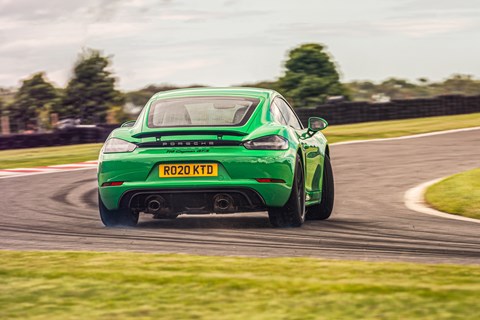
It’s good to be back. Twist the vaguely car-shaped key in the Cayman’s ignition and not four but six cylinders at the small of your back bark and settle into a reassuringly rattly idle. At low revs some of the all-time great Porsches sound like a cutlery drawer being emptied into a distant washing machine, and the GTS continues that theme. It’s not noisy or unpleasant but it is mechanical, gritty. It bodes well for what’s to come.
A quick recap: until this car came along, the only current-generation Porsche Cayman you could buy with a flat-six rather than a turbo’d flat-four was the £75k 718 GT4. To both justify the investment in creating the GT4’s 4.0-litre engine and un-wring the hands of enthusiasts (and automotive journalists) who’ve bemoaned the lack of a ‘normal’ Cayman with six cylinders, Porsche has installed it in this new, £64k 718 GTS 4.0. The power output has been turned down by around 20bhp and the GTS has slightly less racy suspension components than the GT4 (and a less racy appearance, going without the big dog’s fixed rear wing and chin spoiler) but it feels like something of a bargain. Relatively speaking, of course. Gambolling across the Lincolnshire Wolds on a fine summer’s day, the GTS feels 95 per cent as good to drive as the GT4 for 85 per cent of the price.
Like the best Caymans, the getting-to-know-you phase in the GTS is remarkably short. Within moments of its wheels rolling you feel like you know it inside out. And it’s got your back: handling is apparently viceless at road speeds, as safe and as stable as it is eager. The way it changes direction is quite something, the GTS turning on its heels like an action movie hero in a slow-motion gunfight. Time feels malleable in this car; there’s always space to modify your inputs, to try something different at apparently any stage of a corner.
The GTS’s tactility is enhanced by the six-speed manual gearbox, for the time being the only transmission for the GTS (although a PDK paddleshift will be available as an option in the near future). A weighty, mechanical-feeling shift, it’s a pleasure to use. The revs blip automatically on downshifts in the sportier driving modes but heel-and-toe purists can still rev-match themselves should they wish by leaving the settings in Normal mode.
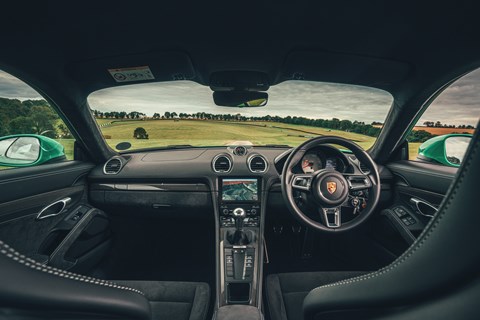
Above 4000rpm or so, the flat-six’s gruff burr morphs into a snarling howl but, despite Porsche’s best efforts, it doesn’t quite sound as raw and evocative as six-cylinder Caymans of old. The particulate filter required to clear emissions regs, necessary for the greater good, is no doubt partly the reason. Regardless, this is an engine with plenty of character and no little pace, too – the GTS is a quick car. It would feel even quicker if it didn’t have such long gearing though, an established Boxster/Cayman bugbear. Second gear is good for more than 80mph, and you could easily drive all day without broaching the 4000rpm sweet spot where the engine really comes alive, in terms of both sound and muscle. Peak torque of 310lb ft arrives north of 5000rpm and the 394bhp of peak power not until 7000rpm, by which time you’d be going too fast for most roads. A close-ratio kit, though an impossibility out of the factory, would make a lovely car lovelier still.
Still, these are nits so small they’re barely pickable. For the most part, the Cayman feels like it’s milled from a solid billet of just-rightness. The others have their work cut out. But if any cars can beat the Cayman, it’s the trio assembled on these pages, three of the greatest sports cars on sale today. As we approach our meeting point, they start to assemble like ships answering a siren call. In my mirrors, art editor Mal Bailey looms in the malevolent-looking BMW M2 CS, the best (but priciest) M2 yet. Up ahead, the small, lithe form of a white Alpine A110S peels out of a petrol station, staff writer Jake Groves at the wheel. And judging by the sound of a barely silenced supercharged V6 on the breeze, road test guru Adam Binnie can’t be far away in Lotus’s spellbinding Evora GT410.
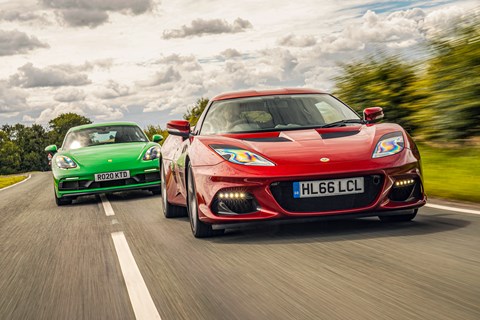
We’ll be testing predominantly on the road, where these cars belong, but the challenging Cadwell Park circuit has kindly allowed us to sneak onto the track for a short while too, which will tell us a few things the roads can’t, if only for a tantalisingly brief snapshot. But frankly, after the drive I’ve just had on the way here in the GTS, it feels like we might as well call the verdict now. The Cayman feels so perfect the others can’t have a chance – can they?
BMW M2 CS: pre-flight briefing
Why is it here?
Yes, it’s a three-box saloon with back seats, but the M2 has always had the soul of a sports car. The CS has more soul than ever, as an up-to-11 final fling for the Mk1 M2 before it ends production.
Any clever stuff?
The engine’s from the M4 Competition, with a heavy-duty cooling system and extra oil cooler. Peak torque is sustained longer than other M2s, from as low as 2350rpm. Copious use of carbonfibre for various body panels is a double-whammy for weight saving as its natural stiffness obviates the need for extra bracing.
Which version is this?
As this generation of M2 nears the end of its lifecycle, there are two variants left on sale: this range-topping M2 CS, and the M2 Competition. The CS costs a distressing £23k more than the Competition. In return, you get an extra 40bhp, adaptive suspension and plenty of carbonfibre, including its deployment on the roof, bonnet, mirrors and aero surfaces, among other detail tweaks.
Read our BMW M2 CS review
BMW M2 CS: it’s a bit of an animal
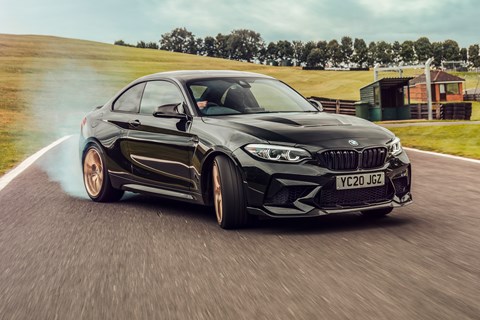
So this is it, the last of the line for the M2 before an all-new successor appears next year. Not a bad way to bow out: the CS is a livewire and no mistake. Were you observing our convoy from a distance, the BMW might look a bit like a saloon interloper, its room-for-four roofline half a foot higher than the sports cars. Then you get closer and see the forged wheels (finished in shy and retiring gold here), the gaping vents, the splitters and gurneys. And hear it: the turbocharged 3.0-litre straight-six, borrowed from the M4 Competition, shrieks through four tailpipes. The CS’s roof is made from broad-weave carbonfibre but it might as well be a skinhead; it’s the hardest car here.
The most powerful car here too, by a bit at 444bhp, but it feels like a lot. Behind its fat alcantara wheel the gulf in performance between the M2 and the others feels vast. After the Cayman, it feels almost comically fast. Put your foot down at a generous cruising speed in fifth and it surges forward like the GTS in a lower gear at half the speed. Sounds good too, if not quite as sonically satisfying as the Porsche or Lotus. It’s perhaps a tad noisier than the Cayman at a cruise; the Porsche is quiet by sports car standards, other than a bit of tyre buzz on coarse surfaces.
The 2-series is a small BMW but in this company it feels like driving a block of flats from the first floor. Your first instinct after swapping from the Cayman is to try to lower the seat only to find it’s already on the bottom of its travel. Likewise in the Lotus and the Alpine, which set their seats a touch higher than their appearance would suggest. Only the Porsche can offer a proper, floor-scudding sports car driving position.
The BMW can offer a proper gearbox (and a proper handbrake), our car’s six-speed manual being the default choice and DCT an option. Great as the latter is, there is something special about driving a potent modern car and conducting its gears yourself. Like the Porsche, the throttle is blipped automatically on downshifts but switching the stability control off disables that function, clearly assuming a hardcore helmsmith is at the wheel. Although you’re most likely to drive with the stability switched off on a circuit, where you might appreciate the autoblip’s help for fast lapping. And Lincolnshire has just the place.
A bike trackday is in progress as we roll into Cadwell Park, two-wheeled projectiles screaming like castrati howler monkeys as they rocket around its rollercoaster layout. The circuit is kindly allowing us to sneak on for photography and a handful of laps while the bikes break for lunch, and the M2 is like a cork released from a bottle.
It’s only when you turn the traction control off that you realise just how busy it’s been (and how subtly it intervenes) to keep the M2’s rampant 444bhp and 406lb ft in check, like an efficient PA looking after a loose-cannon boss. Unshackled, the CS can transform from neat and tidy lapper to Hollywood car chase, happy to hang its tail out at every turn depending on the weight of your right foot.
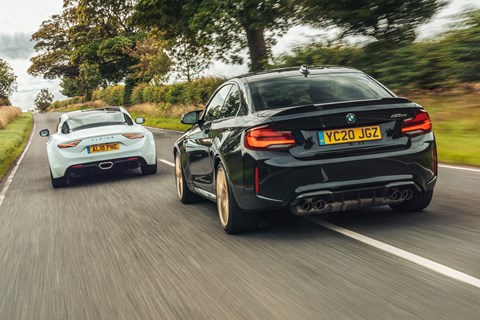
On the track, it has the power to keep big slides going, although its delivery is a little odd. There’s not much below 4000rpm or so, and it’s in the high reaches of the rev range that it really starts to get into its stride, so you need to use lower gears and higher revs than you might expect. That goes for the road too, where there’s a blurry edge of turbo lag exiting roundabouts in third gear, for example. Often it needs a downshift to second beforehand to stay on the boil, almost like a naturally-aspirated car. The Cayman’s throttle response would feel great by comparison, were its edge not dulled by tall gears.
Like the Cayman GTS, the M2 CS rides on adaptive dampers as standard, and like all modern M cars there’s a plethora of mix ‘n’ match modes for steering, throttle response and said dampers. I actually find the middle Sport setting more comfortable than slightly looser Comfort (washboard Sport+ is best left for the track), and the CS rides very well for such a focused car. It’s a smidge smoother than the Porsche, and far more so than the Alpine. Only the silky Lotus is ahead for ride comfort.
Price is a real stumbling block for the CS (that, and a character and aesthetic that’s maybe a bit too lairy for some). A £75k (£81k as tested) tag is hard to ignore when the M2 started from around £44k back in 2016. That notwithstanding, this is the best M2 I’ve ever driven. Perhaps it’s a shame this last hurrah couldn’t have been a no-holds-barred M2 GTS, with the back seats deleted and a half-rollcage. But the presence of back seats and a decent boot makes the CS’s larger-than-life abilities all the more remarkable.
Lotus Evora GT410: pre-flight briefing
Why is it here?
It’s an oldie but a goodie. When we took the GT410 on a 400-mile pilgrimage to Jim Clark country we were spellbound anew by its handling balance and one of the best exhaust notes of any car on sale today. As a ride, handling and excitement benchmark, the Evora is still right up there.
Any clever stuff?
Bonded extruded aluminium chassis and an obsessive approach to weight saving and driving dynamics. And the arcane witchcraft that can make the engine once found in a Toyota Camry sound like a classic Le Mans car.
Which version is this?
Lotus has had so many confusing Evora variants over the years it could be a Mastermind subject but the range is now down to two cars: this, the GT410, and the GT410 Sport, which is noisier, firmer and has fewer creature comforts. This one is pitched as Lotus’s comfiest, most everyday-usable car.
Lotus Evora GT410: veteran’s day
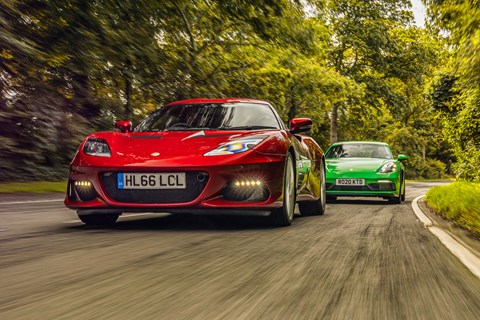
The case against the Lotus? It’s old (the Evora’s been around for more than a decade, although it’s been developed throughout), it’s expensive (£80k+), its interior isn’t a patch on the others here… Then its V6 fires and we turn to one another with wolfish grins and remember why it got the invite. For total immersion, not much matches an Evora.
The GT410 variant was launched earlier this year but already feels like an old friend since we took it on an epic jaunt to Scotland in CAR’s May issue. So brightly did its handling shine on that trip we decided it warranted a place in this test.
Adam picked up the 410bhp Lotus from Hethel and is besotted with it. Jake is less convinced. ‘The interior is hard to make excuses for,’ he says, shaking his head. ‘The gearchange is awkward, and there’s a disconcerting dead spot at the top of the brake pedal’s travel…’
He does have a point. The aluminium pedals are oddly positioned – I can’t quite put my finger (or toe) on what feels wrong but your clutch leg is arrow-straight while the brake pedal is a bit of a stretch to the left for your right foot, and at an awkward height. And there’s that awkward jump-in play at the top of the pedal that Jake noted, although the brakes certainly bite well when you get there. As a side note, for all their many deep-running talents none of these cars have particularly wonderful brake feel. The Alpine ‘feels like treading on a tennis ball,’ as Jake neatly puts it. The Porsche’s pedal is a little numb feeling and needs plenty of pressure, whilst the M2’s optional carbon-ceramic discs (a snip at £6250) are hair-trigger over-servo’d.
All of the cars here, on the other hand, have standout steering – but the Lotus’s hydraulic set-up is something else again. It’s weighty without feeling heavy, and brim-full of feel. You feel like you’ve been driving the others wearing oven gloves. Same story with the throttle response, easily the best here, thanks to supercharging and well-chosen gear ratios. And likewise the engine note. Never mind the venerable Toyota-sourced V6’s humble background, this is one of the very best sounding cars on sale today. No need to bother with the £5k titanium exhaust option. It already sounds like a racecar. (Especially since the redline isn’t in the right place on the tacho, so there’s a good chance you’ll snag the rat-tat-tat limiter until you get used to it.) And while there’s a little more patter over low-frequency bumps than I remember from last time, true to form the Lotus has the most supple ride too.
The GT410 is the softest Evora in years, with an emphasis on comfort (and it does roll notably more than the other cars here), but it feels the most at home of all of them at Cadwell Park, even at low speeds for the camera. It turns in more incisively than the Cayman, which has a tendency toward safe understeer, and the Evora’s steering is so detailed it feels as though you can tell how many layers of paint are on the kerbs. If, for you, nothing is more important than the way in which you and a car carve corners, this has to be your car.
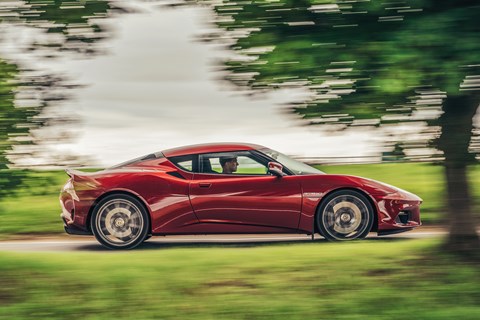
Thinking back to when I tested the car at Lotus’s Hethel test circuit in the pouring rain, it’s remarkable how safe it makes you feel, considering you’re driving a mid-engined car with a fair bit of weight behind you. It never stops talking to you and letting you know what it’s up to next: ‘Just to let you know, I’m going to understeer here. After that, if you leave it a bit late to back off, I might snap into oversteer but, if I do, I’ll give you fair warning, okay?’
Photos in the bag and test over, we’re heading home under a storybook sky, the last rays of sunlight punching through pink-tinged clouds. Jake’s up front in the Lotus, Adam close behind in the Cayman (being pelted with stones from the Evora’s exposed rear tyres, the guards in its rear vents long lost in one of Lotus’s Marie Kondo component-binning sessions in the name of weight-saving). I’m following in the Alpine, windows down to enjoy the balmy summer air. On the breeze, I hear Jake drop the hammer in the Lotus and Adam follow suit in the Cayman. All of a sudden, I really wish I was in the Evora. We stop for fuel a little further up the road. ‘Okay, I understand the appeal now. It’s just… raw,’ Jake grins, reaching for the super-unleaded. Despite its GT leanings, the Evora still feels like a specialist, unfiltered driving machine. The Alpine is more cohesive, the Cayman more polished, the M2 more potent but the Lotus mainlines the biggest adrenaline rush, enough to make you forget its flaws. Enough to win this test?
Alpine A110S: pre-flight briefing
Why is it here?
It’s impossible not to fall in love with the less-is-more A110. Now in harder, faster S spec, it’s good enough to take on the toughest sports cars we can throw at it.
Any clever stuff?
Aluminium everything: 96% of the A110 is made from the stuff. That includes much of the engine, shared with the Megane RS (and certain Espace variants, believe it or not), with a high specific power output to go with its light weight.
Which version is this?
Where the regular A110 rides on comparatively soft suspension, the A110S has been pulled taut with 50% stiffer springs, 100% stiffer anti-roll bars and sits 4mm lower than the regular A110. There’s a bit more boost pressure and peak torque lasts longer. The S costs around £8600 more than the base A110 Pure model.
Read our Alpine A110 review
Alpine A110S: just enough, plus a bit
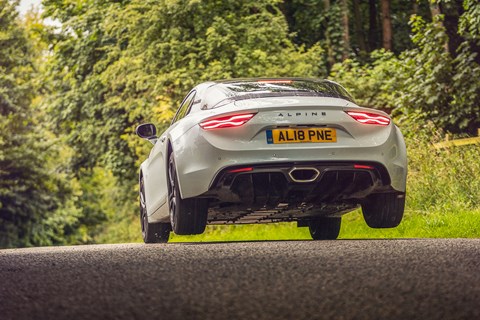
‘Excuse me,’ asks the man who’s just driven back and forth three times to take a closer look at the Alpine, ignoring the gold-wheeled M2, the supercar-shaped Lotus and the Very Green Porsche, ‘Can I just ask – what type of car is this?’
There’s so much that’s utterly beguiling about the A110, whether you’re a fully anoraked car bore or a casual passer-by. It looks dainty in this company; even the Cayman appears oversized next to it. Its dimensions are closer to the classic car it’s styled after than most modern-day performance cars. If the regular A110 feels a bit like a classic to drive too, the A110S is more of a restomod. Introduced last year, it sits on wider tyres and lower, firmer suspension, and power is boosted (literally, with another 0.4 bar) by 39bhp to 288bhp. If you love the regular car but find it a bit too soft for its own good and wish it had a bit more precision, and a bit more poke, the S is the Alpine for you. The regular A110 could compete with the Cayman for charm, and came close for dynamism; the S gives its handling the extra accuracy to take it on squarely.
The inquisitive bloke’s eyes glazed over halfway through that explanation and he’s sidled away, so we’d better go for a drive. You feel the firmer suspension immediately. Springs and anti-roll bars are both dramatically stiffened over the standard A110, which breathes with the road just as sweetly as the magic-carpet Lotus. The A110S feels rather brittle by comparison. It’s a mite less forgiving than the Cayman with the Porsche’s adaptive dampers’ ‘normal’ mode but the Cayman is a touch tougher in Sport. (The Alpine and Lotus ride on passive rather than electronically controlled dampers.) Stiff as the A110S is, it isn’t a deal breaker; you could live with it, and some hot hatches are firmer still.
Compared with the regular turbo flat-four Porsche 718, the Alpine’s turbo four is a nicer engine to drive, despite its smaller size and less exotic in-line layout. Compared to the 4.0-litre flat-six, however, it doesn’t quite have the character to compete. It makes a pleasantly rorty sound and you get some intake and turbo whooshes from behind your head but it’s not an engine that stays in your memory banks the way the other three here do. Great throttle response, though, thanks to torque spread more broadly in the S than the standard A110, from 2000rpm all the way to 6400rpm. It feels more responsive than the Cayman, even if it can’t hit as hard.
It’s ironic that the pure A110S is the only car here without a manual gearbox. The twin-clutch unit is a little less involving than a three-pedal Alpine would be (what a tantalising thought that is), but the reasons for making the A110 auto-only outweighed those of a manual option, including extra cabin space. That said, the Alpine feels the most cramped inside of the quartet, and the awkward-to-reach space where the gear linkage would have been is about all there is for cockpit stowage space (not that you buy a sports car for places to put things). Like the Cayman, it has two boots, front and rear, but they’re much smaller and the rear one warms your luggage more than the Porsche (but doesn’t cook it as thoroughly as the Evora). While you could daily drive the Cayman and the M2, the Alpine and the Lotus feel more like weekend cars.
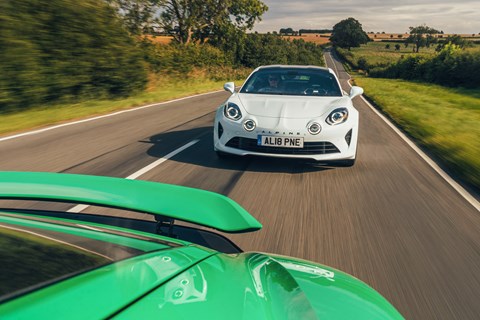
The Alpine can’t live with the Evora and the Cayman for straight-line speed, and certainly not the M2, but that’s not what the A110S is about. It’s a momentum car, and you can carry a great deal of speed with minimal effort, dipping into its always-on torque reserves and using weight transfer in fast corners to help it up onto its toes, merrily shimmying and sashaying its way along B-roads.
As much fun as the Cayman? It’s close; very close. The Alpine drives and handles beautifully, but for my money the Cayman controls its vertical movements a bit more fluidly and telegraphs its limits with greater clarity, helped by its more neutral weight distribution (the A110S concentrates its mass a little more to the rear).
There are a few quality niggles, especially next to the Porsche and BMW. The seatbelt slips down my collarbone as the little strap on the seat that guides it has broken, and some of the ergonomics are questionable (electric window switches the same position, texture and shape as the handbrake switch, for example). It has more of a toy-like feel than the other cars here. Which is fine, given that it’s such a captivating plaything.
There’s so much inherently right and good and vital about the Alpine that I’d completely understand if you made like the bloke in Horncastle, ignored the other three and flocked straight to it.
The final reckoning
Objectively, the Cayman GTS has the fewest chinks in its armour. It’s beautifully tactile to drive, and it feels beautifully built too. You can imagine a giant picking it up, shaking it like a toddler with a toy car and putting it down again without a single piece of trim being out of place. (You might not feel quite so confident about the Lotus or the Alpine.) Unusually for a Porsche, its price feels like a good deal, as much as parting with more than £60k for a sports car can. Naturally, though, you don’t get much kit for your money: tw0-zone climate control, cruise control, parking sensors and electric folding mirrors all cost hundreds of pounds extra each.
But what you do get as standard is a spellbinding chassis. Adam makes the valid point that it’s almost too good; too easy. Within a few miles you feel you’ve learned everything there is to know about it, where the other cars have more layers to dig through and master. But to drive the Cayman is to experience a deep sense of satisfaction.
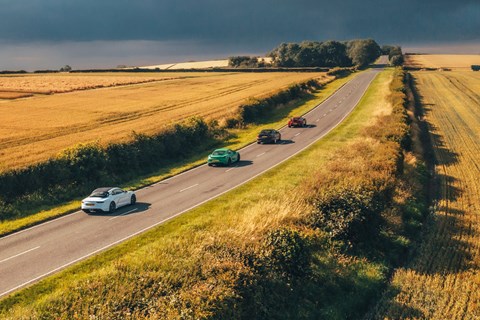
The Alpine is the same, and as such it feels wrong to put it in last place – I probably won’t sleep the night this page goes to press. It’s a gem of a car, and deserves all the praise heaped upon it. But judged purely on thrills – the car as a plaything – the Lotus is a driving experience that will stay with you longer. The Alpine is the more complete car but I’m compelled to put the GT410 ahead of it.
If this were a test between the three mid-engined sports cars, that would be that. But where to put the M2 CS? It comes at things from a completely different angle (usually sideways) and yet it achieves just as much driving pleasure and excitement. For some it’s a bit too much; a louche wrecking ball to the mid-engined precision instruments. But judged purely on grin factor, the BMW is a car to make you smile almost as much as the Porsche. It takes second place.
But if you’re going to treat yourself, half measures make no sense. And nothing here makes as much sense as the Porsche Cayman GTS.
With huge thanks to the Cadwell Park circuit – visit cadwellpark.co.uk or call 0843 453 3000 for event and trackday information
Cayman GTS 4.0 vs M2 CS vs Evora GT410 vs A110S
First place: Porsche 718 Cayman GTS 4.0
Every bit as brilliant as the GT4 for less cash. Only a gear ratio transplant short of perfection
★★★★★
Second place: BMW M2 CS
Bold, brash and brilliant fun. The wildest yet most usable car here. Just a shame it’s so expensive.
★★★★★
Third place: Lotus Evora GT410
Plenty of reasons to doubt it until you drive it. Approaching retirement but still addictive
★★★★★
Fourth place: Alpine A110S
Something had to come fourth and somehow it’s this. Still one of the best cars in the world.
★★★★★
Check out more CAR comparison tests here